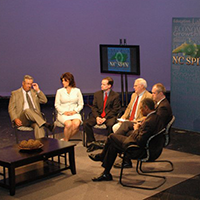Job needs propel college reforms
Published April 18, 2024
By John Hood
I’ve long been bullish on North Carolina’s community colleges. In the past, I’ve praised the system’s cost-effectiveness, its capacity to serve nontraditional students, and the impressive labor-market returns for associate degrees and certificates in such fields as industrial technology, home repair, computer sciences, and health care.
Today, I’ll offer you three pieces of good news about our colleges and explore what they portend for the future of North Carolina’s economic and civic life.
First, a report released last month showed that state community colleges enrolled 393,227 students at the beginning of this academic year, up 4.1% from the previous year. Because many of these students are pursuing their education or training part-time — and the propensity to do so may vary from year to year — looking at full-time-equivalent (FTE) students offers a cleaner comparison. That figure was 105,174 as of fall 2023, up 5.3% from the previous year and just 2,217 shy of the FTE enrollment in 2019, before the onset of COVID.
North Carolina’s trends compare well to those of other states. For the nation as a whole, community-college enrollment rose 2.6% last year, and remains 12.5% below the pre-COVID peak (ours is just 2% below the peak).
Keep in mind that students enroll in these institutions for a variety of reasons. Some are recent high-school graduates who plan to transfer to four-year universities after taking one or two years of general-college courses. Others are recent high-school graduates pursuing what they may see as a terminal associate’s degree or formal certificate relevant to their career of choice. Still others are high-school students in dual enrollment, completing courses that will count toward both diplomas and future degrees. And some are recent high-school dropouts or much-older adults returning to school after a sometimes-lengthy gap.
Community colleges can and should accommodate all these learners and more. But different categories of students pursuing different goals require different approaches.
For example, for the roughly one-third of first-time enrollees in community colleges who transfer to bachelor’s programs, state leaders spent much of the 2010s crafting and implementing articulation agreements that made their academic lives easier. They sought to reassure students that community-college credits would, indeed, be honored by their future universities.
The agreements worked. A new report from the Community College Research Center ranks North Carolina 10th in the nation in the share of its transfer students who complete their bachelor’s degrees within six years. Our state also boasts the highest rate of transfers from two-year to four-year schools in the country.
Reacting to these findings, Grace Hall of the James G. Martin Center for Academic Renewal observed that college success still depends on students planning ahead and exercising self-discipline. Still, thanks in part to those articulation agreements, “North Carolina students have the power to make their choices count.”
What about enrollees seeking particular job skills or occupational credentials? Our funding model hasn’t always served them, their schools, or their prospective employers well. So here’s another piece of good news: the General Assembly is about to consider a new funding model, Propel NC, proposed by the state board of community colleges.
The model would allocate more funds to high-demand fields such as advanced manufacturing, public safety, and allied health. Every three years, the community-college system would reevaluate funding levels based on job and salary data. This sounds like a good concept to me, though I suspect some of the details will change as lawmakers ask questions and suggest modifications.
Public higher education in North Carolina is heavily subsidized. Tuition is low by national standards, while state appropriations in FY 2022 amounted to about $12,513 per FTE student compared to a national average of $10,237. That’s driven primarily by university funding, however, not community colleges.
Implementing some version of the Propel NC model would require a modest increase in state funds. Its advocates argue that community colleges not only produce labor-market returns but also serve as critical hubs in local communities. I find their argument persuasive.
John Hood is a John Locke Foundation board member. His latest books, Mountain Folk and Forest Folk, combine epic fantasy with early American history.







